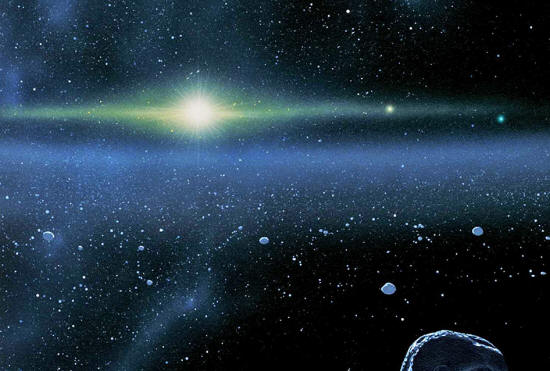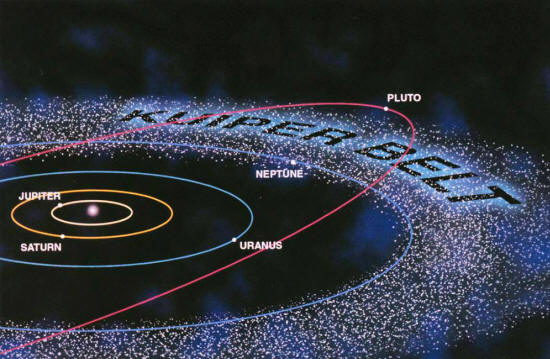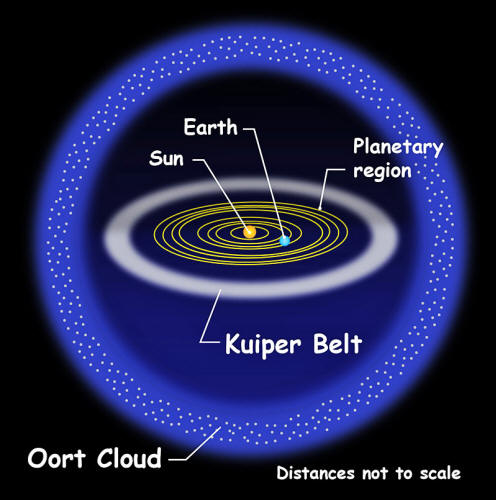|

by Kevin Montana
June 12,
2017
from
MessageToEagle Website
Spanish version

Located in an area of the
outer solar system, just beyond the orbit of Neptune
the Kuiper Belt contains hundreds
of thousands of icy bodies.
This is a rather unexplored region of space and the Kuiper Belt
provides an intriguing cosmic mystery. For some unknown reason, it
abruptly ends roughly about 50 astronomical units from the Sun.
This is puzzling because theoretical models predict an increase in
number of icy bodies. Instead, the rocks stop. The drop off is so
dramatic, that the feature of nothingness that exists outside the
Kuiper Belt has been nicknamed
the Kuiper Cliff.
In 1950, astronomer Gerard Kuiper predicted the existence of
the Kuiper Belt.
Proof of his discovery
came 18 years later...

Kuiper Belt
The Kuiper Belt (named after Kuiper) extends from about 30 to 55 AU
and is probably populated with hundreds of thousands of icy bodies
larger than 100 km (62 miles) across and an estimated trillion or
more comets.
Pluto and three other
dwarf planets reside in the Kuiper Belt.
Since the discovery of
the Kuiper Belt we have learned a lot about
Kuiper Belt Objects, but there are
still questions we cannot answer, not yet at least.
Why Does The
Kuiper Belt Suddenly End?
The most controversial theory suggests that a lurking planetary body
the size of Earth or Mars has swept up the objects gravitationally,
creating the Kuiper Cliff.
Supporters of this theory state this is evidence of the mythical
Planet X or Planet 9 that
astronomers are still trying to find.
Some years ago,
astronomers ran several simulations, and discovered that a small
planet, around half the size of the Earth could have formed inside
Neptune’s orbit. It could have been tossed into a bigger orbit by
Neptune, and then knocked around the orbits of the ice balls,
distorting their orbits and creating the Kuiper Cliff.
The birth of this hypothetical planet could have occurred during a
time when there was plenty of material in the early solar system.
Another theory, perhaps less exciting but nevertheless plausible, is
that the Kuiper Belt does not end abruptly at all. There could still
be objects in the region, but they are so small that we cannot
observe them.
The cause of the Kuiper Cliff remains unknown.
References
Kuiper Belt
- 10 Need-to-Know Things
-
February 2016
from
NASA Website
Spanish version

-
The
Kuiper Belt and the
Oort Cloud are regions of
space. The known icy worlds and comets in both regions are
much smaller than Earth's moon.
-
The Kuiper Belt
and the Oort Cloud surround our sun, a star. The Kuiper Belt
is a doughnut-shaped ring, extending just beyond the orbit
of Neptune from about 30 to 55 AU. The Oort Cloud is a
spherical shell, occupying space at a distance between five
thousand and 100 thousand AU.
-
Long-period
comets (which take more than 200 years to orbit the sun)
come from the Oort Cloud. Short-period comets (which take
less than 200 years to orbit the Sun) originate in the
Kuiper Belt.
-
There may be are
hundreds of thousands of icy bodies larger than 100 km (62
miles) and an estimated trillion or more comets within the
Kuiper Belt. The Oort Cloud may contain more than a trillion
icy bodies.
-
Some dwarf
planets within the Kuiper Belt have thin atmospheres that
collapse when their orbit carries them farthest from the
sun.
-
The Kuiper Belt
and the Oort Cloud are regions of space and therefore do not
have moons. However, several dwarf planets within the Kuiper
Belt have moons.
-
The Kuiper Belt
and the Oort Cloud are regions of space and therefore do not
have rings. No objects within these two regions are known to
have rings.
-
The first mission
to the Kuiper Belt is
New Horizons. New Horizons reached
Pluto in 2015.
-
These two regions
of space are not capable of supporting life as we know it.
-
Fact: Both the
Kuiper Belt and the Oort Cloud are named for the astronomers
who predicted their existence during the 1950s:
Gerard Kuiper and
Jan Oort.
|




